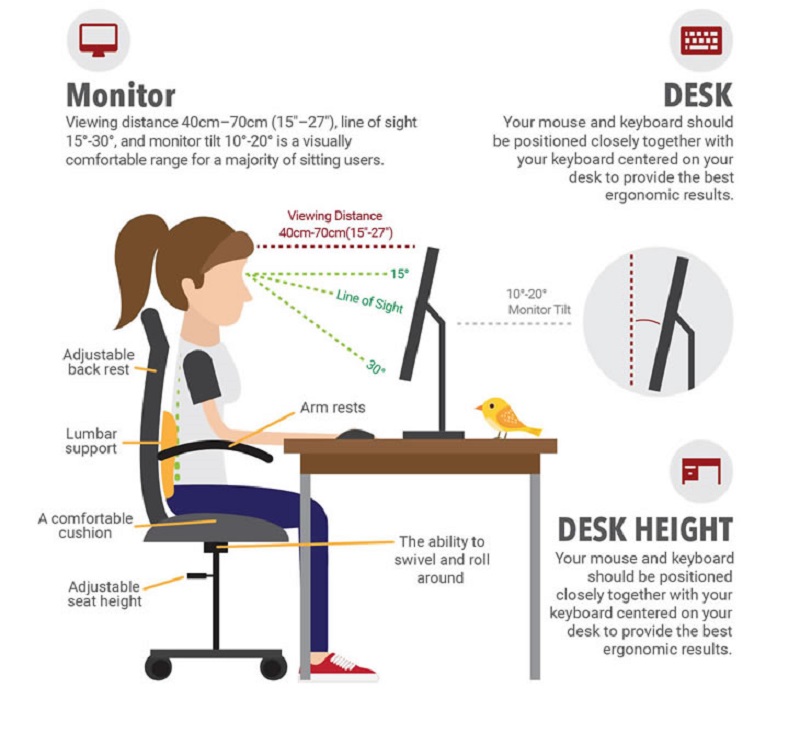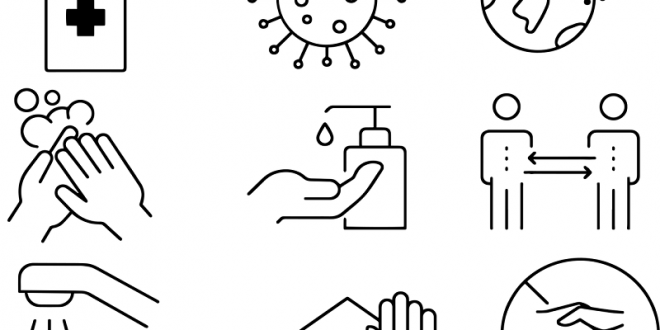The COVID-19 pandemic has drastically changed the human’s social life in ways that no one envisioned. It took all of us by surprise and many lost their jobs, businesses, and their loved ones across the globe. The construction sector jobs plummeted as all the work came to halt and almost all of the commercial, industrial, sports, educational, movie theatres, and hotel buildings are closed since early February or March 2020.
Fortunately, life is getting back to normal with strict measures of disease prevention protocols. Normally, sustainability is the main concern for real estate owners, developers, and practitioners. There are many standards and protocols to achieve sustainable building. The occupant’s safety, health, and wellbeing were addressed by a dedicated building standard developed by the International WELL Building Institute (IWBI). It was widely accepted and applauded by all stakeholders of the building industry. IWBI following its pro-active and leadership role announced its new Health-Safety rating for all building types considering the post COVID scenario.
It will be a first of its kind, evidence-based third party verified rating focusing on prevention and preparedness, resilience, and recovery potential of the built environment. Buildings and occupants must adapt to the new culture of disease prevention in which social distancing is one of them. Considering the closure of buildings for a longer period buildings must follow certain protocols to safeguard occupant’s health and safety. According to a study, stagnant water in the building’s pipes could lead to the buildup of bacteria which causes Legionnaires’ disease, a respiratory condition. Similarly, un-used HVAC and other systems can expose occupants to different illnesses.
Unlike LEED certification this Health-Safety rating will not offer multiple levels of certification (silver, Gold, or Platinum). It will consist of one level that signifies to occupants that certain health standards have been met. The pricing of this is yet to be decided and will also provide options to owners to integrate this rating evaluation with their normal WELL or WELL portfolio certification. The WELL Health-Safety Rating will accept registrations in June 2020 from all types of buildings and facility typologies, including offices, restaurants, hotels, retail establishments, manufacturing plants, warehouses, sports stadiums, arenas, theaters and other entertainment venues, schools, multi-family housing, and many others.

This rating system is the result of the Task Force on COVID-19 and Other Respiratory Infections relentless work over the past couple of months. This task force is a group of nearly 600 public health experts, virologists, government officials, academics, business leaders, architects, designers, building scientists, and real estate professionals, which was established in late March to help guide IWBI’s response to the pandemic. This prestigious panel of astute experts not only incorporated their knowledge and experience but also leveraged the standards developed by the Centers for Disease Control and Prevention (CDC), the World Health Organization (WHO), the Department of Health and Human Services, Occupational Safety and Health Act (OSHA), the National Institutes of Health (NIH) and IWBI.
This rating is based on three main principles of
- Operational Policies
- Maintenance Protocols
- Emergency Response
To achieve this certification owners must document, implement, and verify practices in sanitation, touchless navigation surfaces, waste disposal, water quality, and emergency preparedness in their buildings.
The details about the standard and strategies will come but here we are going to provide highlights of the strategies devised for better occupancy in the post COVID scenario.
1- Promote Clean Contact
COVID-19 can spread through respiratory droplets of an infected person or by having close contact with that person. Furthermore, research suggests that It can remain airborne for up to three hours and on some surfaces up to 72 hours. Maintaining good cleaning protocols, through hand sanitizer and soap are effective strategies to reduce infection transmission. It also enhances personal and organizational resilience.
WELL Strategies
Hand Washing (WELL Feature 08)
Providing sufficiently large sinks, disposable soap containers, and hand drying towels can reduce pathogen transmission.
Cleaning Products and Protocol (WELL Feature X09)
Implement comprehensive cleaning protocols for high touch surfaces and restrict the use of cleaning and disinfecting products that contain hazardous ingredients. Conduct training, spread awareness and maintain cleaning logs for the record.
2- Improve Air Quality
Good air quality is of paramount importance when it comes to COVID prevention as it transmits through droplets. It is vital to keep indoor air as fresh as possible. Proper maintenance of HVAC systems, humidity control, air purification system, and excellent cross ventilation are essentials components to maintain good indoor air quality. Breathing in poor or bad air can cause several respiratory diseases.

Ventilation Effectiveness (WELL Feature A 03)
Introduce fresh air through natural or mechanical means to avoid the accumulation of contaminations indoor produced by humans or other products.
Enhanced Ventilation (WELL Feature A 06)
Implement advanced ventilation strategies such as increased outdoor air supply, demand-control ventilation, displacement ventilation, and advanced air distribution that can enhance air quality.
Operable Windows (WELL Feature A 07)
Provide operable windows for users and try to take maximum advantage of this throughout the design. Furthermore, encourage the users to open windows when outdoor air quality is good. Outdoor air quality can be monitored through sensors or by using government data for the city.
Air Filtration (WELL Feature A 12)
Follow international standards for sufficient air filtration and purification methods. Prepare and maintain a log for the air filters to be changed after a specific period as recommended by manufacturer or standards.
Microbial and Mold Control (WELL Feature A 14)
Use ultraviolet air treatment methods to control microbial and mold growth.
Moisture Management (WELL Feature W07)
Implement design strategies to limit moisture accumulation and the potential of mold growth from water infiltration and condensation within buildings.
Humidity Control (WELL Feature T07)
Recommended relative humidity range is 40% to 60%. It needs to be maintained to reduce the growth of pathogens and proper productive working conditions for occupants.
3-Maintain Water Quality
Water can impact human health to a large extend. Chlorination of water is used to make it pathogen-free but if left stagnant for a period it cannot control the pathogen growth due to its reduced effectiveness, which is a key factor to be considered before chlorination. Water can play a role in the spread of infectious diseases.

Fundamental Water Quality (WELL Feature W01)
Maintain standards for coliforms and turbidity for all water likely to be used by occupants.
Water Contaminants (WELL Feature W02)
Maintain standards for drinking water related to organic pollutants, dissolved metals, and disinfectants as mentioned in WELL standard.
Enhanced Water Quality (WELL Feature W04)
Meet standards for water aesthetics and taste as mentioned in the WELL standard.
Water Quality Consistency (WELL Feature W05)
Perform quarterly water testing and maintain the filtering protocols.
4-Manage Risk and Create Organizational Resilience
Emergency preparedness is a risk management strategy and organizations must prepare and evaluate their resilience in case of emergency. Companies should use survey results or direct complaints made by the occupants regarding the building’s performance. Occupant surveys are an established tool for understanding and evaluating people’s perceptions of indoor environmental conditions, wellness policies, and their health and well-being. Many surveys can be customized for an organization’s specific needs to address topics like worker performance, satisfaction, and well-being before, during, and after a period of remote work.
Emergency Preparedness (WELL Feature C15)
Develop an emergency plan and prepare accordingly for all the possible emergency responses.
Family Support (WELL Feature C10)
Enable workers and caregivers to take care of their children and other dependent family members.
Occupant Survey (WELL Feature C03)
Get feedback from occupants for the evaluation of occupant experience, health, and well-being.
Enhanced Occupant Survey (WELL Feature C04)
Collect and respond to in-depth feedback from building users on their comfort, satisfaction, behavior, health, and other robust factors related to their well-being, both before and during occupancy.
5- Support Movement and Comfort Including Work from Home
COVID-19 presented the work from home scenario, which was never imagined by anyone, at least of this scale. Distraction-free environment, Ergonomics, and proper activity are essential components of any good working condition. Before COVID-19, 44% of the companies never allowed workers to work from home which makes this scenario new and surprise for anyone. Furthermore, this new experience pushed workers to establish suitable workstations at their respective places to work efficiently. No standard established working conditions at the home level. However, few strategies can be adopted from the WELL standard.

Visual and Physical Ergonomics (WELL Feature V02)
Improve comfort and reduce strain through the implementation of several activities. Visual comfort, safety, and general wellbeing through ergonomic design and education.
Active Furnishings (WELL Feature V07)
Provide active furnishing to discourage sedentary behavior and prolonged sitting.
Enhanced Ergonomics (WELL Feature V10)
Provide ergonomics audits, run occupants surveys, and give access to professionals so that occupants can have recommendations for improvement.
Self-Monitoring (WELL Feature V12)
Provide workers with wearables so that they can monitor their individual’s physical activity metrics.
6-Strength Immune System
Human’s lifestyle largely impacts their immune system. Smoking, drinking, and poor dietary behavior reduce immunity whereas exercise and fitness protocols can increase the immunity of an individual. A sedentary lifestyle can pose a risk of heart disease, type-2 diabetes, and many other illnesses. Providing individuals with access to health-promotion strategies, education and resources can help them to cultivate healthy habits and resilience in response to physical and mental health stressors.
Health Services and Benefits (WELL Feature C05)
Provide access to essential health services, screenings, and assessments.
Mental Health Support (WELL Feature M03)
Increase availability of and access to mental health support services and care.
Health Promotion (WELL Feature C06)
Cultivate a culture of health through various health promotion strategies, including regular communications, stakeholder involvement, and health risk assessments.
Smoke-free Environment ( WELL Feature A02)
Deter smoking, minimize occupant exposure to secondhand smoke, and reduce smoke pollution.
Tobacco Prevention and Cessation (WELL Feature M13)
Provide access to tobacco cessation support programs and promote prevention by providing education on the health consequences of tobacco use.
Fruits and Vegetables (WELL Feature N01)
Promote the consumption of fruits and vegetables by making them easily accessible.
Drinking-Water Promotion (WELL Feature W06)
Promote hydration by making high-quality drinking water readily available.
Physical Activity Spaces and Equipment (WELL Feature V08)
Provide physical activity spaces and equipment to occupants at no additional cost to support physical activities and exercise routine among occupants.
Physical Activity Promotion (WELL Feature V11)
Provide active interior design and different options for physical activities.
Circadian Lighting Design (WELL Feature L03)
Aligning the occupant’s sleep cycle with natural circadian rhythm is of cardinal importance otherwise it can reduce productivity and imparts negative health effects. To maintain that provide appropriate exposure to light for maintaining circadian health.
Sleep Support (WELL Feature M11)
Support healthy, restorative, and consistent sleep habits through policies, education, and resources.
7- Foster Mental Resilience
Having access to health services, mental health support, and restorative programming are important before, during, and after any health crisis. Stress is known to weaken the immune system. Mental health is not simply the absence of a mental health condition. A connection with nature through plants, water, light, and views, as well as an indirect connection through natural materials, patterns, colors, or images, has been found to improve mood, recovery from stress and concentration.
Mental Health Promotion (WELL Feature M01)
Promote mental health and create awareness through different advocacy and educational programs.
Stress Support (WELL Feature M05)
Identify and mitigate sources of workplace stress and provide programs that support stress management.
Restorative Opportunities (WELL Feature M06)
Create opportunities for mental recovery and restoration by providing micro- and macro-breaks from the workplace.
Restorative Programming (WELL Feature M08)
Support access to programs that promote restoration, relaxation, and relief from mental fatigue or stress.
Access to Nature (WELL Feature M02)
Incorporate nature into the design of the interior and exterior spaces by integrating plants, water, light, and views, as well as natural materials, patterns, colors, or images.
Enhanced Access to Nature (WELL Feature M09)
Provide enhanced access to plants, water, and natural views.
Light Exposure and Education (WELL Feature L01)
Provide appropriate light exposure in indoor environments by using daylighting or electric lighting strategies and provide education about the importance of light for health.
Enhanced Daylight Access (WELL Feature L05)
Integrate daylight into indoor environments and provide windows with views outside.
8-Champion Community Resilience and Recovery
Providing spaces for community engagement and connection can foster social cohesion, community empowerment, and collective trust. Besides, strong local food networks help communities prepare for emergencies. Pandemics, wars, and natural disasters disrupt supply chains and can heighten food insecurity globally. Individuals with the community and social support generally have better mental health than those without strong community connections.

Civic Engagement (WELL Feature C11)
Engage community integration through engagement and volunteerism.
Community Access and Engagement (WELL Feature C16)
Create opportunities for community members to connect and collaborate.
Food Production (WELL Feature N12)
Improve access to fresh produce and provide opportunities for on-site food production.
Local Food Environment (WELL Feature N13)
Support healthy food access and reduce environmental barriers to healthy eating.
Buildings, communities, and organizations play a leading role in supporting our health and well-being, as well as our collective ability to prepare for and respond to global health challenges like the one we are experiencing now.
Author: Muhammad Shoaib
More of his articles here.
Muhammad Shoaib is Sustainability and Project Management Consultant. He is also a Collaborative Facilitator of ILFI in Pakistan and ex-UN-SDSN Pathway Fellow. He holds LEED AP, WELL Faculty, and Building performance Analyst Credentials. He can be contacted @ Linkedin or email: [email protected]
 Constructionshows
Constructionshows
